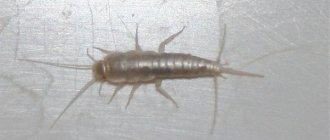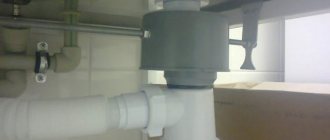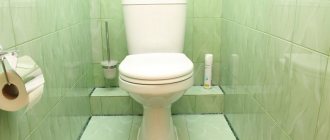Why does stagnation occur?
There are two reasons why the water began to drain poorly: mechanical and operational.
Attention! The mechanical reason is that a clogged pipe is caused by foreign objects getting into the drain pipe. It could be sand, hair, pet fur, and more.
Operational cause occurs due to emergencies in the communications system itself. Due to wear and tear of old equipment. Maybe your drain pipe is not inclined enough or its diameter is small. This may be a violation during planning or repairs.
Blockage in the bathroom
Factor 1 - dirty siphon
V-siphon
First of all, you need to become familiar with siphons:
- Bathroom drain fittings can be of two types - bottle and V-shaped siphons (you see one of them in the top photo);
- in essence, the siphon serves to create a water seal that cuts off the smell from the sewer pipe;
Bottle siphon
- in addition, the siphon may have a bottom valve - this is a kind of plug or plug for the bathroom that allows you to retain water;
- There are also siphons with overflow, and in most cases the instructions recommend using them, but this is only if the bathroom has an overflow (hole);
- but no matter what type of siphon you have, the reason for its blockage is always in the area of the water seal - debris from dirty water accumulates there;
- the same reason answers the question of how to get rid of the smell that comes from dirt and stagnant detergents;
- Solving this problem is quite simple - you need to unscrew the siphon, disassemble it and wash it with detergents in running water;
- but if you have water left in the container, then a bath valve will serve you well - you can close the outlet and remove only the lower part of the siphon to wash it.
Sometimes you hear the question of why the bottom of a steel or cast iron bathtub turns black, while everything is fine with acrylic bathtubs. This is the interaction of water with paint, and there is nothing you can do about it. Although, if you wash it thoroughly, the process will happen much slower.
Factor 2 - the pipe to the riser is clogged
The most common location of plumbing fixtures
The diagram above shows the most common placement of plumbing fixtures. Let's figure out what to do if water doesn't drain well from a particular node.
If you don’t have water flowing in the sink and bathtub, but everything is fine with the sink, then the blockage most likely formed in the green area, up to the sink. So, by elimination, you can identify a clogged area to clean it.
If you have determined where the blockage has formed, then you do not need the entire drain system, but only one section, and most likely there is no inspection there. Therefore, you can only run the plumbing cable into the pipe through the removed siphon (under no circumstances do this through the drain).
In the bathroom it is located too low and getting to it is also not very easy. Therefore, in such cases, it will be much more convenient for you to remove the siphon from the entrance under the sink and insert the cable through the free outlet towards the bathroom.
Plumbing cable
The plumbing cable used for cleaning can have different lengths, and it is made of either nylon or steel (the price is almost the same). For a regular bath, five or even three meters will be enough for you.
In the private sector, this may not be enough - the distance between bathrooms is too large and 10 m will be needed. But this is not always the case - if there is a revision, then the distances are significantly reduced.
Do not use a metal cable with a fluffed end - it will scratch even metal pipes, not to mention plastic ones. And these same scratches then act as a trap for solids, that is, they retain them, resulting in blockages.
Factor 3 - the blockage is not in the apartment
Sewer riser in the toilet
Now we’ll try to figure out why water doesn’t drain from any of the plumbing fixtures. Remember that the toilet is usually located last. First of all, you will need to find out how things are going with your neighbors below.
If everything is in order there, it means that you have a clogged riser, which is supposed to be revised according to the project. But it may also be that it is not there. In this case, you can get into this pipe through a fan tee - remove the outlet from the toilet, and you have free access to the riser - as a rule, a cable of five or even three meters is enough here.
In the photo - sewerage with inspection in the basement
But what to do in cases where there is a flood in the apartment, and you live on the first floor, or the same situation is with the neighbors below, right down to the first floor? In this case, you need to look for the cause in the basement.
The blockage is located on one of the turns. Here it will be somewhat easier, since according to the project, each turn must be equipped with an inspection. You should act according to the principle of exclusion, and you need to start from the far end of the basement - remove the plug from the inspection, and if there is no water, close it and move on to the next lid.
Let's say that you opened the last revision, but nothing flowed from the pipe, but when you opened the penultimate revision, water came out of it. Consequently, the blockage will be between the last and penultimate revision and, most likely, it will be a knee.
Such problems arise due to the carelessness of residents - someone simply pours water into the toilet after washing, but some T-shirt still remains unnoticed, which passes along the riser and gets stuck at some turn.
What are the cleaning methods?
You can clear the blockage mechanically and chemically. During use, the drain collects household deposits, such as soap and fat residues, hair and other contaminants. It is because of these deposits that the water begins to drain poorly.
You can try to remove these accumulations with special-purpose tools. Use: “Mole”, “Tiret”, “Mr. Muscle”. They are produced in the form of powders, concentrated liquids, gels and even granules. Choose the composition of the product that is convenient for you.
Use of chemical compounds:
- First, you need to study the instructions for use, which are located on the packaging of the product you have chosen.
- Then you need to pour or pour into the drain hole as much product as indicated on the package.
- Record the time according to the instructions and go about your business.
- After the specified time, drain the water.
- If the drain is not completely cleaned, the procedure must be repeated.
Using a plunger
With the mechanical method, you can use a plunger. This is a special tool designed to clear clogged pipes. How to use it correctly:
- Fill the bath with water so that it completely covers the water stop valve. Water awakens to push through contaminants after exposure to a plunger.
- Take a plunger and place it against the drain so that it covers the drain hole and fits tightly enough to the bathtub itself.
- Don't forget to close the water overflow window located at the top of the bathtub itself. This will protect against the overflow of dirty liquid after the procedure.
- Make 5-6 sharp and fairly strong upward and downward pressures with the plunger. But just without lifting the valve from the bathtub.
- Remove the appliance to give the water a chance to push clogs down the drain.
Using a cable
The use of a plumbing cable refers to mechanical cleaning. This is the last of the drain cleaning options and the most serious and time-consuming. It is used when you have already tried everything, but nothing has helped.
For home use, the following types of cables are used:
- rope, the diameter of which is six millimeters. Made of galvanized steel. It is very durable and flexible. It easily overcomes joints and bends of the sewer system. At the end the cable looks like a brush, which is used to pull debris out of pipes. For home use, it is enough to purchase five meters. This cable also penetrates loose layers of dirt well.
- spring-wound, the diameter of which is nine millimeters. In appearance, this is a structure wound in a spiral. Empty inside. A handle is attached to this structure. This cable is very elastic. It navigates turns in sewer drains quite easily. There are no additional elements at the end. It ends with a tip or simply a bend, which facilitates movement in pipes.
Use of cables:
- The cable is inserted into the bathroom drain.
- They begin to move slowly and smoothly through the pipes, as if turning counterclockwise.
- If the progress is weak, you need to increase the rotation of the cable. In this way the blockage is pushed through. If it doesn’t work, you need to try to wind it around the tassel at the end of the cable and pull it out.
- If you feel that the water has begun to pass, you need to make a few more movements forward and backward.
- After you have cleaned the drain, the cable must be washed with cleaning agents, dried and put away in the designated place.
Causes
Even modern sewage systems sometimes fail: the water in the bathroom does not drain well, an unpleasant odor appears, or worse, the toilet drain is clogged. Why doesn't the system cope with its functions?
Why does blockage occur?
Improper operation will affect stable operation. The problem is directly caused by:
- Household pollution. Particularly harmful are the fatty fractions deposited on the walls of the pipes. Hair and tissue fibers stick to such layers and accumulate in siphons, elbow bends, and pipe joints, forming a kind of mesh.
- High mineralization of water causes the deposition of salts in areas of variable cross-section, where the direction and speed of flow changes.
- Plumbing rust is retained by grease and hair plugs, forming an insurmountable barrier.
- Accidental or intentional discharge of large food debris, household waste, rags, and household items into the sewer system.
- Backpressure. A clogged house sewer well is the cause of trouble for residents of the lower floors: the water does not drain, and what is drained from above ends up in your bathtub.
Factors that have an indirect impact:
- Lack of mesh on the drains of the sink and bathtub; installation of siphons without safety traps.
- Errors in route installation: failure to comply with recommended slopes and angles; narrowed internal passage.
The smaller the internal diameter of the pipeline, the greater the slope along the flow: from 0.02 (2 cm per 1 m) to 0.03 for diameters of 100 and 50 mm, respectively.
Lack of a coarse filter on the water supply, faulty drain filter of the washing machine, dismantling of the mixer aerator.
Special cases
A cast iron pipe loses throughput faster than a plastic pipe due to corrosion, greater internal roughness, and the formation of differences in the interfaces of elements. Often they cannot be cleaned due to complete overgrowth and fragility of the walls, which are destroyed by weak impacts.
The likelihood of clogging a combined kitchen and toilet drain riser is higher than a separate one, since kitchen drains are saturated with fatty compounds. The network of the old building is not designed for the simultaneous operation of a dishwasher and washing machine; if the consumption exceeds the design, the water will drain slowly.
Individual sewerage systems for private housing are often equipped with a concrete pit. Due to poor waterproofing, when groundwater rises, the reservoir overflows, and sanitary waste has nowhere to go.
Modern septic tanks are equipped with insulated plastic tanks that prevent infiltration of perched water. Timely emptying of containers prevents stagnation in the bathroom.
There is no blockage, but the water does not drain
It happens that dirty water in the toilet or bathroom does not drain well when the pipes are not clogged. There are several options:
- The riser below the apartment connection is clogged. After filling the free volume of the pipe, the liquid stops passing.
- An air lock has formed. With intensive use of toilet and kitchen plumbing, the liquid, acting like a piston, captures air from the pipe, a vacuum occurs, the level of the toilet water seal drops, and rumbles from the neck of the bathtub. With the restoration of air pressure, the liquid that did not have time to escape is forced back. If the discharge of wastewater continues, the pressure does not have time to equalize with atmospheric pressure. The process becomes oscillatory and air pockets form. Overlapping in the attic or roof leads to similar consequences.
- The membrane is jammed, the pendulum gate of the dry shutter is jammed: the locking mechanism partially blocks the passage, disassembly and repair are necessary.
Traffic jam areas
Pollution preferentially settles when the flow slows down. Stagnant pockets are especially susceptible to overgrowing: siphon elbows, cavities of eccentric transitions, corrugated hoses, sagging pipe strings.
Poorly made connections: misaligned, with burrs, squeezed out seals - potential obstacles for small particles and fibers. Rectangular shaped parts work like inertial mud traps: the flow hits an obstacle, turns 90˚, and the suspension loses speed and precipitates.
A clogged sewer riser causes great inconvenience. Coupling joints, connection to a basement sewer, and a manhole are likely places for deposits.
There is no alternative to replacement
Prevention
Prevention is the best way to deal with blockages.
- Periodically it is necessary to treat the drain with chemicals. There is no need to wait until stagnation occurs and the water does not go down the drain.
- You can also sometimes use a plunger. It won't be difficult to make a few movements.
- Sometimes you need to unscrew the siphon and clean it of dirty deposits.
These methods are not so complicated that they can be carried out sometimes. But then you won’t have to deal with thorough cleaning of pipes and drains. And if it does happen, you can now do it yourself.
Preventing sewer clogging
To prevent blockages from forming in the bathroom, it is worth taking some preventive measures:
- Install a fine mesh in the drain hole, which will trap debris, hair, and animal fur.
- If you drain the water after washing into the bathtub, then use a plunger at this time to preventively clean the pipeline.
- Clean the sewer system of the entire apartment regularly (1-2 times a year) using household chemicals.
Thus, if the water in the bathroom does not flow well, this indicates a blockage in the sewer line or the drain itself. The easiest way to clean pipes is to use a plunger. In severe cases, it is recommended to use mechanical devices - a cable or use hydrodynamic cleaning. To dissolve stuck organic deposits, it is better to pour strong chemicals into the drain.











